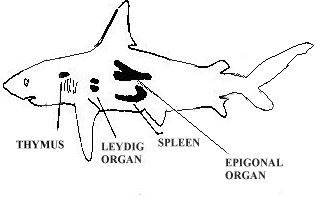 |
SHARK |  |
|---|
| FACTS AND STATS |
Sharks and Cancer |
 |
SHARK |  |
|---|
| FACTS AND STATS |
Sharks and Cancer |
Sharks and their relatives, the skates and rays, have enjoyed tremendous success during their nearly 400 million years of existence on earth. One reason for this certainly is their uncanny ability to resist disease. Sharks do get sick, but their incidence of disease is much lower than among the other fishes. While statistics are not available on most diseases in fishes, reptiles, amphibians, and invertebrates, tumor incidence in these animals is carefully monitored by the Smithsonian Institution in Washington, D.C.
The Smithsonian's enormous database, called the Registry of Tumors in Lower Animals, catalogs tissues suspected of being tumorous, including cancers, from all possible sources throughout the world. Of the thousands of tissues in the Registry, most of them are from fish but only a handful (fewer than 25) are from sharks or rays. Most of these are classified as fibrous responses to wounds, parasites, or goiters (enlarged thyroid glands sometimes developed by sharks in captivity), leaving only 8 to 10 legitimate tumors among all the shark and ray tissues examined.
This low incidence of tumors among the sharks and their relatives has prompted biochemists and immunologists at Mote Marine Laboratory (MML) to explore the mechanisms that may explain the unusual disease resistance of these animals. To do this, we have established the nurse shark and clearnose skate as laboratory animals. These sharks and skates are maintained at MML under controlled conditions and utilized in much the same way that mice, rats, guinea pigs, and rabbits are used in more conventional biomedical research.
Initially, we designed experiments to see whether tumors could be induced in the sharks and skates by exposing them to potent carcinogenic (cancer-causing) chemicals. This was done by placing the chemicals in their food or surrounding tank water, or by direct injection into their muscle. Then, we monitored subsequent pathways of metabolism or detoxification of the carcinogens in the test animals. While there were similarities and differences in the responses when compared with mammals, no changes in the target tissues or their genetic material ever resulted in cancerous tumor formation in the sharks or skates.
The chemical exposure studies, encompassing about ten years of research effort, have led us to more recent investigations of the shark immune system. As with mammals, including humans, the immune system of sharks probably plays a vital role in the overall health of these animals. But there are some important differences between the immune arsenals of mammals and sharks. The immune system of mammals typically consists of two parts which utilize a variety of immune cells as well as several classes of proteins called immunoglobulins (antibodies).
Compared to the mammalian system, which is quite specialized, the shark immune system appears primitive but remarkably effective. Sharks apparently possess immune cells with the same functions as those of mammals, but the shark cells appear to be produced and stimulated differently. Furthermore, in contrast to the variety of immunoglobulins produced in the mammalian immune system, sharks have only one class of immunoglobulin (termed IgM). This Immunoglobulin normally circulates in shark blood at very high levels and appears to be ready to attack invading substances at all times.

Another difference lies in the fact that sharks, skates, and rays lack a bony skeleton, and so do not have bone marrow. In mammals, immune cells are produced and mature in the bone marrow and other sites, and, after a brief lag time, these cells are mobilized to the bloodstream to fight invading substances. In sharks, the immune cells are produced in the spleen, thymus and unique tissues associated with the gonads (epigonal organ) and esophagus (Leydig organ). Some maturation of these immune cells occurs at the sites of cell production, as with mammals. But our studies at MML in collaboration with researchers at Clemson University have determined that a significant number of immune cells in these animals actually mature as they circulate in the bloodstream. Like the ever-present IgM molecule, immune cells already in the shark's blood may be available to respond without a lag period, resulting in a more efficient immune response.
Our future plans include further investigations of the differences between mammals and sharks in the regulation of immune cells. Since some new approaches to cancer therapy involve the stimulation of immune cell production, an understanding of the control of proliferating immune cells in the circulating blood of sharks would be valuable. This information may someday lead to improved methods of immune cell regulation in humans, especially cancer patients.
But human health applications from our research are many years in the future, and will rely on continued funding and active collaboration with the drug industry and medical community. Meanwhile, there are many public misconceptions about the clinical potential of shark-derived products for treatment of disease. For example, freeze-dried shark cartilage pills, marketed as food supplements through health food stores and mail order houses, are being touted as miracle cures for cancer as well as arthritis.
The claims are based on research conducted during the 1980's at the Massachusetts Institute of Technology (MIT) and at Mote Marine Laboratory. These studies of cow and shark cartilage were designed to understand how cartilage is naturally able to resist penetration by blood capillaries. If the basis for this inhibition could be identified, it was reasoned, then it might lead to the development of a new drug therapy. Such a drug could control the spread of blood vessels feeding a cancerous tumor, or the inflammation associated with arthritis.
The research showed that only very small amounts of active material, with limited ability to control blood vessel growth, can be obtained from large amounts of raw cartilage. The cartilage must be subjected to several weeks of harsh chemical procedures to extract and concentrate the active ingredients. Once this is done, the resulting material is able to inhibit blood vessel growth in laboratory tests on animal models, when the concentrated extract is directly applied near the growing blood vessels.
Unfortunately, there is no logical reason to conclude that freeze-dried shark cartilage pills taken orally could "seek out" a malignant tumor in a cancer patient and inhibit the blood vessels feeding it in a manner similar to the laboratory tests. Also, there is no reason to think that shark cartilage contains anything which is not found in other animal cartilage. But there is so much more cartilage in sharks, since they have an all-cartilaginous skeleton, that they have served as sources for this material.
Finally, since the limited amount of active material used in the laboratory test must be chemically extracted, there is no reason to assume that this material is released passively from cartilage when still in the animal to inhibit blood vessel growth elsewhere in the body. This means that cartilage, no matter whether in a shark, a cow, a dog, or a human, probably plays no active role in disease resistance in the living animal. The statements made by shark cartilage pill promoters that it is cartilage that gives sharks their immunity to cancer, then, are inaccurate and irresponsible.
This is not to say that the basic research to understand the chemical basis for cartilage resistance to blood vessels shouldn't continue. The potential for this research to lead to new drug therapies is very real. But what should be halted is the use of sharks as a source of cartilage to be ground up and marketed as a panacea, with little or no support for effective results in fighting disease when taken as a food supplement. We owe it to the sharks, but more importantly to the suffering cancer patients, to provide a sound basis for such actions. At this point, no such justification exists.
| Dr. Carl Luer is the Biomedical Program Manager at Mote Marine Laboratory. Dr. Luer's biomedical research uses sharks and skates as laboratory animals models to investigate mechanisms of cancer inhibition and cellular immune function. His studies also include the reproductive biology and embryology of the clearnose skate. Dr. Luer is a member of the Board of Directors of the American Elasmobranch Society. |